Posts Tagged: sun
A Conversation with a Jumping Spider
Photographer: "Well, hello there, Jumping Spider! What 'cha doing?" Jumping Spider: "Sunning myself, that's all." Photographer: "And you're not...
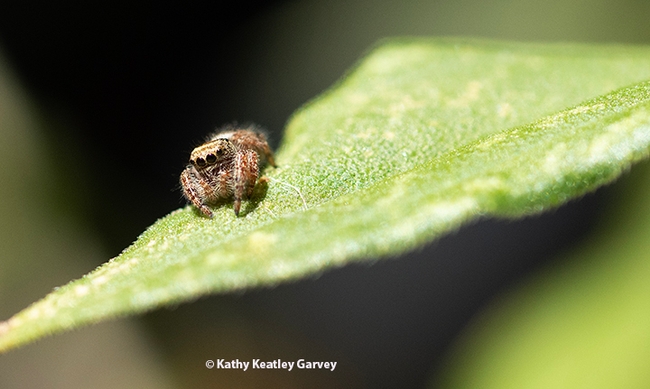
A jumping spider eyes the photographer. (Photo by Kathy Keatley Garvey)
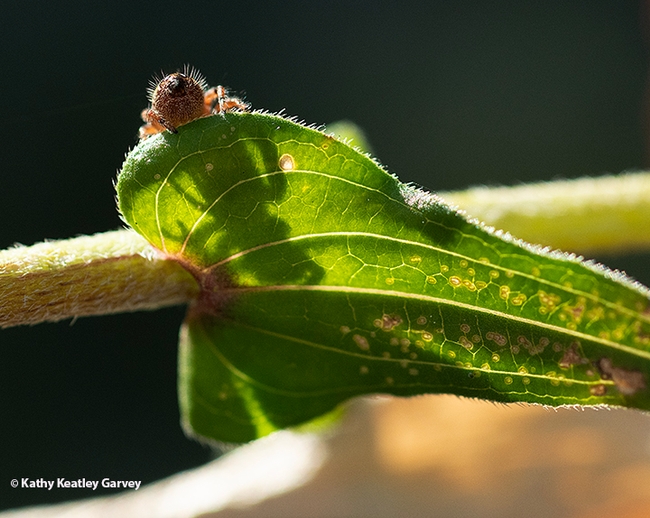
The jumping spider crawls over a leaf. (Photo by Kathy Keatley Garvey)
It's Tough Being a Bee During the Springlike Rains
It's tough being a bee--especially when you have work to do and the rain won't let you out of your hive. But when there's a sun break, it's...
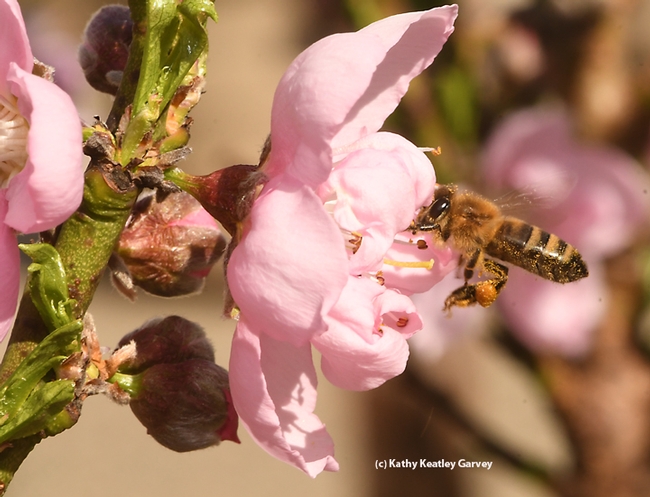
A honey bee pollinating a nectarine blossom in Vacaville, Calif. (Photo by Kathy Keatley Garvey)
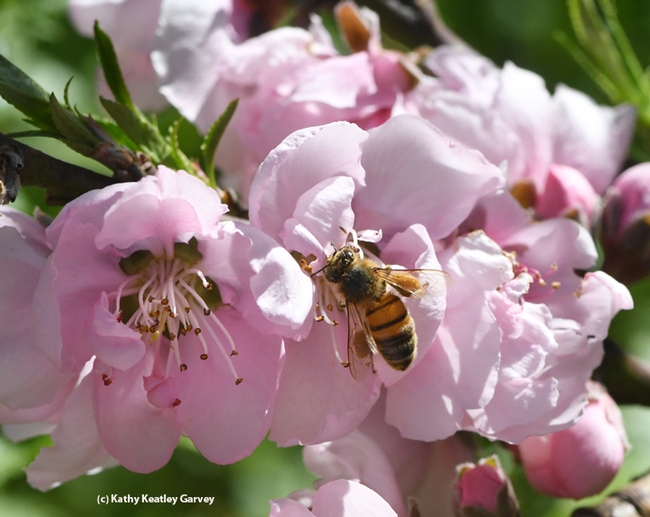
A foraging honey bee takes a liking to a nectarine blossom. (Photo by Kathy Keatley Garvey)
A Gardening I Will Go-I Think?
According to all the garden catalogs that come my way, it’s time to “replant, repot, rejunenate “the front yard. According to those same catalogs, it will cost merely a gazillion dollars for the plants, bulbs, corms, and tubers to accomplish this transformation; and don’t forget about the soil amendments, and fertilizers the folks also want to sell you. Yeah right, I have that kind of money to use as walking round cash! Don’t you?
This year, the front yard lost all the glorious shade that came from the late, great green ash tree that stood for 20 plus years. It’s been interesting to watch the various shrubs and bushes getting acclimated to more sun, less shade. The oleanders made the transition beautifully, but of course, have you ever seen an oleander suffer from the sun? They are now rather happy campers in the hot afternoon sun, bowing gracefully in the Suisun City gale that passes for gentle winds.
The buddleia in the ground near the front door went from full leaf to rather skimpy foliage, but made a roaring comeback – full of blossoms and hummingbirds. The buddleia in the pot, however, is still trying to find a way back from “roasted”, but is managing to hold on until cooler weather when it goes into the ground itself by the side yard gate. It gets water and encouraging words for the efforts!
The other succulents in their cozy pots that are placed around are thriving and growing like weeds, which is why some of their offspring will be at the plant exchange next weekend thanks to new Master Gardener Elizabeth! The new Heucheras that were on the front porch in the shade have taken their temporary places in pots at the edge of the early afternoon semi-shade and the afternoon pure sun. They got set there to find out just how well that spot would suit them. Hurray! They are doing very nicely and I think that area will be their “forever” home.
The only plant that is not really happy with the loss of tree shade is my 17 year-old “star” magnolia which is really missing the shade and the wind break the old tree provided. However, when the new “black tulip” magnolia gets larger than the twig it is, I hope it will provide some relief for its cousin.
There are so many plants I would like to get and put out there, but we are still living with the wreckage from the old tree. Concrete walkway parts are tilted and the driveway badly cracked thanks to the invasive roots of that ash tree; that, along with a (? maybe more?) break in the main lawn irrigation are subjects for many grousings and speculation and just plain hard work. I’ve put it all off till later, but yes, I will do it.
Right now, the “new plant” budget is just big enough for some Dutch Iris (both yellow hybrid and deep blue hybrid) and 8 varieties of Muscari or Grape Hyacinths. Originally planted around the ash tree, the bulbs there “took the hit” when the ash stump was ground out. For over 35 years, wherever I have lived, there have been Dutch iris and Muscari planted around the front yard. The only difference between back then and now are the roots left by darn ash tree that have to be hacked at, ripped out, and planted around. But it will be done! (Right, Bruce? Bruce, can you hear me?)
See you on the 12th at the Master Gardener office for the plant exchange. I KNOW that there is a plant or plants with your name on them for you to take home and enjoy!
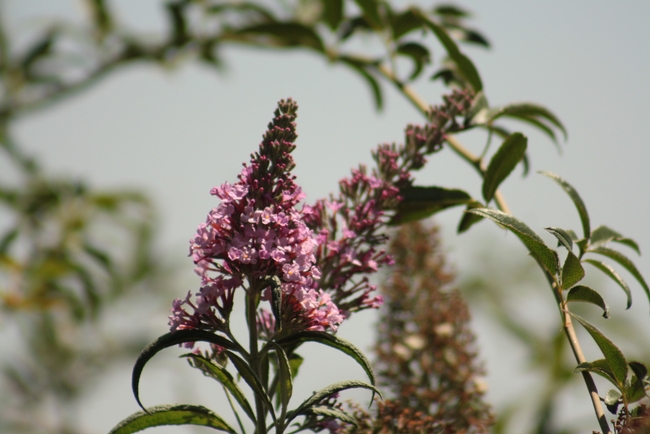
'Pink Charming' butterfly bush. (photo by Jennifer Baumbach)
Better Late Than Never
When I heard that this year's Solano Fair theme was home grown fun and that Carolyn hoped we could grow some of our plants from seed, I knew I had to grow some crested Celosia, Celosia cristata. I had grown them before and really enjoyed their strangeness. I found a seed packet at the SF Flower and Garden Show and got them started.
With our cooler summer though, the plants took longer than I had anticipated to grow and when fairtime came around only one plant had a bloom bigger than an inch or two, so they didn't make the cut. Since they had missed their chance for stardom at the fair, I decided to put them in the blog. Celosias are a part of the amaranth family. Most people are more familiar with the plume form which is commonly available in many nurseries.
The crested form though is my favorite. It is fan shaped and velvety. The edges form convolutions that remind many people of brains. I am partial to the brilliant red coloration. I know from previous years that the red color holds with drying. I've used them in dried arrangements and as decorations on wreaths. This year I was hoping perhaps I might have enough to cover a small wreath form entirely with the dried blossoms. Although they were slow getting started they are blooming their hearts out now.
Celosia are annuals, which means they grow, set flower, then seed and die in one season. However, they are easy to grow from seed (After all, I grew them and I don't have much luck with seeds). They like full sun, they like water, and they grow well in containers. I have about six in individual pots and put several together in one pot. They are great fun and I think children might appreciate their velvety softness.
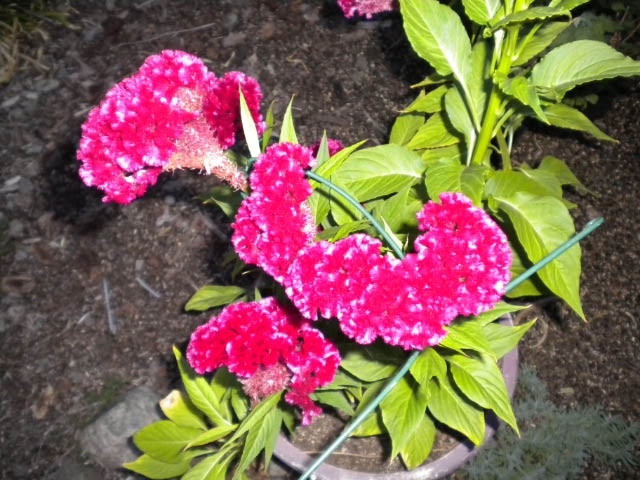
Celosia (photos by Karen Metz)
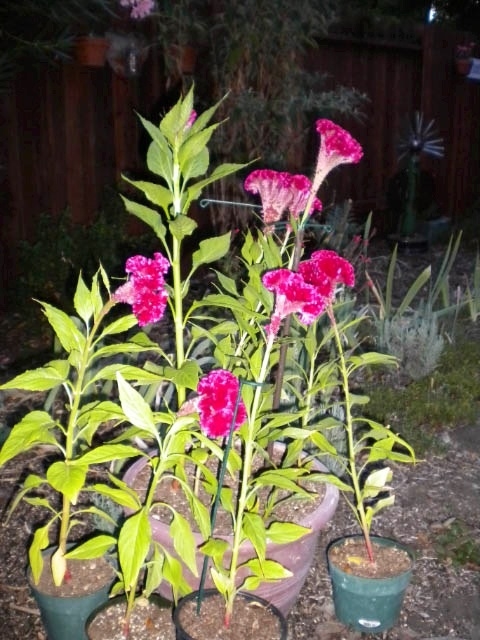
image
Planter boxes and Wildflowers
When my neighbor removed a 30 plus year old Mulberry tree (Morus spp.), I suddenly had sun in a corner of my yard. This motivated me to remove two shrubs and clean up that corner. Because of the tree’s size, I had a lot of big roots that had invaded my yard and would be very costly to have them completely removed. So instead, I decided to have planter boxes made and planted them with, Gaura, Gerber daisy (Gerbera jamesonii), bee balm (Mondarda spp.), dwarf lavender (Lavendula spp.) and Geum, cone flower plants that bees, butterflies and hummingbirds would be attracted to. But I still had the spaces behind the boxes to deal with. The soil was scratched up and a packet of wildflowers seeds were scattered behind the boxes, then a light cover of potting soil was put on top of the seeds. In the mix were nasturtiums, clarkia, and Bells of Ireland.
Spring came and so did the nasturtiums (Tropaealum majus) which really filled in the space with blossoms of orange, pale yellow with touches of red and bright yellow with red spots, and a few white ones here and there. There was also Clarkia, Onagraceae, one of the plants blossom is bright pink, and the other is rose with pink strips. Bells of Ireland, Moluccella laevis pushed their way thru the nasturtium’s to stand tall with their bright green whorls. A Rocket Larkspur (Delphinium ajacis). in a bright blue-purple color.
So now I have color in a part of my yard that once was shade and a forgotten corner. What a difference, it even makes the yard appear larger.
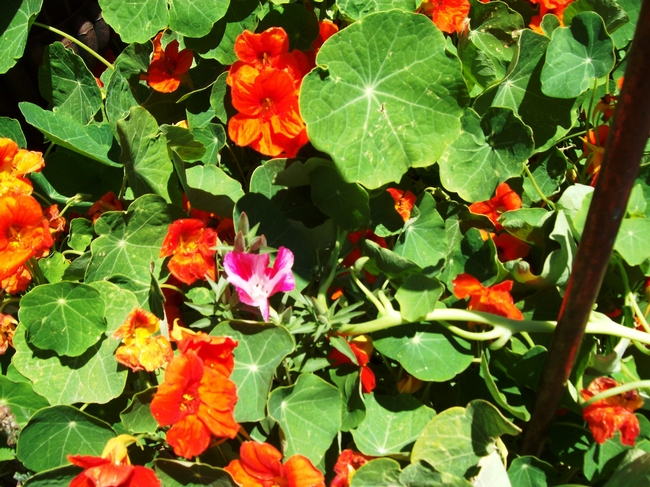
Nasturtium (photos by Betty Victor)
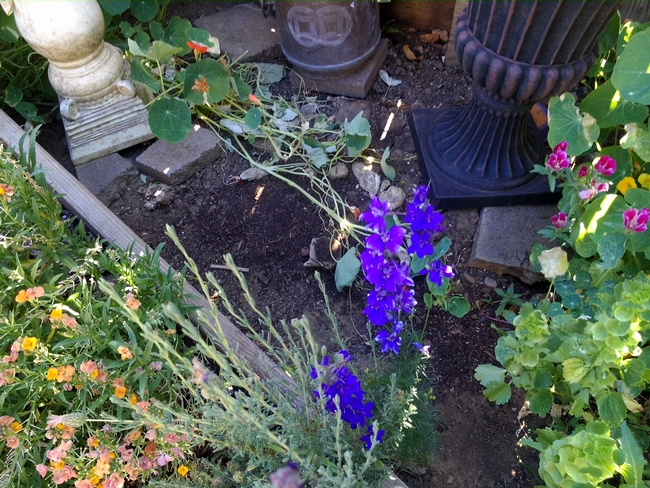
Blue of rocket larkspur, the green of the Bells of Ireland (see right) and the pink Clarkia.

